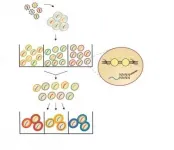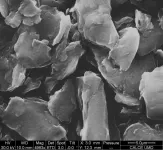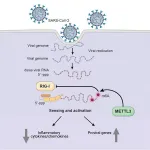(Press-News.org) NEW YORK, NY (April 29, 2021) - In a new resource for the scientific community, published today in Nature Biotechnology, researchers in the lab of Neville Sanjana, PhD, at the New York Genome Center (NYGC) and New York University (NYU) developed CRISPR-sciATAC, a novel integrative genetic screening platform that jointly captures CRISPR gene perturbations and single-cell chromatin accessibility genome-wide. With this technology, they profile changes in genome organization and create a large-scale atlas of how loss of individual chromatin-altering enzymes impacts the human genome. The new method harnesses the programmability of the gene editing system CRISPR to knock-out nearly all chromatin-related genes in parallel, offering researchers deeper insights into the role of DNA accessibility in cancer and in rare diseases involving chromatin.
Recent advances in single-cell technologies have given scientists the ability to profile chromatin, the complex of DNA and proteins that resides within the nucleus of individual cells. Chromatin is often called the "gatekeeper" of the genome because its proteins act as packaging elements for the DNA, either promoting or refusing access to it. This controls gene expression processes in the cell, such as turning on or off specific genes. Changes in the chromatin landscape have been linked to diverse human traits and diseases, most notably cancer.
In an initial demonstration of CRISPR-sciATAC, the Sanjana Lab team designed a CRISPR library to target 20 chromatin-modifying genes that are commonly mutated in different cancers, including breast, colon, lung and brain cancers. Many of these enzymes act as tumor suppressors and their loss results in global changes in chromatin accessibility. For example, the group showed that loss of the gene EZH2, which encodes a histone methytransferase, resulted in an increase in gene expression across several previously silenced developmental genes.
"The scale of CRISPR-sciATAC makes this dataset very unique. Here, in a uniform genetic background, we have accessibility data capturing the impact of every chromatin-related gene. This provides a detailed map between each gene and how its loss impacts genome organization with single-cell resolution," said Dr. Noa Liscovitch-Brauer, a postdoctoral fellow in Sanjana's lab at the New York Genome Center and NYU and the study's co-first author.
In total, the team targeted more than 100 chromatin-related genes and developed a "chromatin atlas" that charts how the genome changes in response to loss of these proteins. The atlas shows that different subunits within each of the 17 chromatin remodeling complexes targeted can have different effects on genome accessibility. Surprisingly, nearly all of these complexes have subunits where loss triggers increased accessibility and other subunits with the opposite effect. Overall, the greatest disruption in transcription factor binding sites, which are important functional elements in the genome, was observed after loss of AT-rich interactive domain-containing protein 1A (ARID1A), a member of the BAF complex. Mutations in BAF complex proteins are estimated to be involved in 1 out of every 5 cancers.
In addition to the CRISPR-sciATAC method, the team also developed a suite of computational methods to map the dynamic movements of the nucleosomes, which are the protein clusters that DNA is wrapped around. When there are more nucleosomes, the DNA is tightly wound and less available to bind transcription factors. This is exactly what the team found at specifical transcription factor binding sites involved in cell proliferation after CRISPR knock-out of ARID1A. When targeting a different chromatin-modifying enzyme, these same sites underwent an expansion in nucleosome spacing, demonstrating the dynamics of nucleosome positioning at specific sites in the genome. The CRISPR-sciATAC method allowed the team to systematically explore this genome plasticity for multiple chromatin-modifying enzymes and transcription factor binding sites.
"We really focused on making CRISPR-sciATAC an accessible technique -- we wanted it to be something that any lab could do. We produced most of the key enzymes in-house and used simple methods for single-cell isolation that do not require microfluidics or single-cell kits," said Dr. Antonino Montalbano, a former postdoctoral fellow in Sanjana's lab at the New York Genome Center and NYU and the study's co-first author.
To develop the CRISPR-sciATAC technology, the researchers used a mix of human and mouse cells to create a tagging/identification process that allowed them to split and barcode the nuclei of cells as well as capture the single-guide RNAs required for CRISPR targeting. The work builds off prior single-cell combinatorial indexing ATAC-seq (sciATAC-seq) work from Dr. Jay Shendure at the University of Washington and other groups developing new single-cell genomics methods. CRISPR-sciATAC also uses an unique, easy-to purify transposase that was developed in the NYGC's Innovation Technology Lab. A key technical hurdle was optimizing experimental conditions to simultaneously capture the CRISPR guide RNAs and genome fragments for accessibility profiling while also keeping the nuclear envelope of each cell intact.
"Integrating chromatin accessibility profiling into the genome-wide CRISPR screens provides a new lens for us to understand gene regulation," said Dr. Sanjana, Core Faculty Member, NYGC, Assistant Professor of Biology, NYU, and Assistant Professor of Neuroscience and Physiology, NYU Grossman School of Medicine, the study's senior author. "With CRISPR-sciATAC, we have a comprehensive view into how specific chromatin-modifying enzymes and complexes change accessibility and orchestrate the interactions that control gene expression. Chromatin sets the stage for gene expression, and here we can measure the impact of different mutations on chromatin rapidly. We hope this atlas will be a broadly useful resource for the community and that CRISPR-sciATAC will be used to produce similar atlases in other biological systems and disease contexts."
INFORMATION:
About the New York Genome Center
The New York Genome Center (NYGC) is an independent, nonprofit academic research institution that serves as a multi-institutional hub for genomic research. Leveraging our strengths in whole-genome sequencing and genomic analyses, our mission is the advancement of genomic science and its application to drive novel biomedical discoveries. NYGC's areas of focus include the development of computational and experimental genomic methods and disease-focused research to better understand the genetic basis of cancer, neurodegenerative disease, and neuropsychiatric disease. Recently, the NYGC also directed its expertise to COVID-19 research.
NYGC harnesses the expertise and builds on the combined strengths of our faculty, staff scientists, member institutions, scientific working groups, affiliate members, and industry partners to advance genomic discovery. Central to our scientific mission is an outstanding faculty who lead independent research labs based at the NYGC, and hold joint tenure-track appointments with one of our member institutions.
Institutional founding members of the NYGC are: Cold Spring Harbor Laboratory, Columbia University, Albert Einstein College of Medicine, Memorial Sloan Kettering Cancer Center, Icahn School of Medicine at Mount Sinai, NewYork-Presbyterian Hospital, New York University, Northwell Health, The Rockefeller University, Stony Brook University, and Weill Cornell Medicine. Institutional associate members are: American Museum of Natural History, Georgetown Lombardi Comprehensive Cancer Center, Hackensack Meridian Health, Hospital for Special Surgery, The New York Stem Cell Foundation, Princeton University, Roswell Park Cancer Institute, and Rutgers Cancer Institute of New Jersey. For more information visit http://www.nygenome.org.
Media Contact:
Karen Zipern, Senior Director, Communications, NYGC
kzipern@nygenome.org
c: 917-415-8134
Exploring extreme environments can put significant operational challenges on the engineering systems we depend upon to safely explore and at times operate within.
Within high-value and safety-critical applications, such as space exploration or sub-surface drilling, the extreme and at times dynamic operating conditions within the environment, can make it challenging to understand the life expectancy of critical components and sub-systems. Hence, it's a highly complex and at times impossible situation to accurate understand therefore predict.
To have safe, resilient and economically viable operations within these challenge environments, it is vital ...
Researchers at University of California San Diego School of Medicine have discovered one way in which SARS-CoV-2, the coronavirus that causes COVID-19, hijacks human cell machinery to blunt the immune response, allowing it to establish infection, replicate and cause disease.
In short, the virus' genome gets tagged with a special marker by a human enzyme that tells the immune system to stand down, while at the same time ramping up production of the surface proteins that SARS-CoV-2 uses as a "doorknob" to enter cells.
The study, published April ...
The burden of student loans in the U.S. continues to grow unabatedly, currently accounting for a total of $1.7 trillion in household debt among nearly 45 million borrowers. "The introduction of income-based repayment over the past decade has made student loans rather complicated products," Paolo Guasoni of Dublin City University said. As borrowers navigate this complex process, they face long-term consequences; people with student debt are less likely to own homes or become entrepreneurs, and generally postpone their enrollment in graduate or professional studies. Though legislative reform is necessary to combat this problem on a grand scale, individual borrowers can take steps to ...
Hydrogen as a clean, renewable alternative to fossil fuels is part of a sustainable-energy future, and very much already here. However, lingering concerns about flammability have limited widespread use of hydrogen as a power source for electric vehicles. Previous advances have minimized the risk, but new research from the University of Georgia now puts that risk in the rearview mirror.
Hydrogen vehicles can refuel much more quickly and go farther without refueling than today's electric vehicles, which use battery power. But one of the final hurdles to hydrogen power is securing a safe method for detecting hydrogen leaks.
A new study published in Nature Communications documents an inexpensive, spark-free, optical-based hydrogen sensor that is more sensitive ...
Study Take-Aways
Unprecedented novel discoveries have implications for characterizing biodiversity for all life, conservation, and human health and disease.
o This finding provides novel avenues of research to increase immune defenses, particularly relevant for emerging infectious diseases, such as the current COVID-19 pandemic.
The flagship paper presented whole genome sequence analyses of 16 vertebrate species to illustrate high quality, near error free, near complete, low cost reference genome assemblies.
o Though near 400 species have been sequenced at some level, the quality today reflects ...
Alzheimer's disease is characterized by the abnormal accumulation and spread of the tau protein in the brain. An international study can now show how tau spreads according to four distinct patterns that lead to different symptoms with different prognoses of the affected individuals. The study was published in Nature Medicine.
"In contrast to how we have so far interpreted the spread of tau in the brain, these findings indicate that tau pathology in the brain varies according to at least four distinct patterns. This would suggest that Alzheimer's is an even more heterogeneous disease than previously thought. We now have reason to reevaluate the concept of typical Alzheimer's, and in the long ...
As state and local policymakers and politicians made the decision to enact stay-at-home orders last March in response to the coronavirus pandemic, a recent study found that more stringent public health measures put in place directly correlated with lower virus case numbers during the first two months of the pandemic.
The study, "More Stringent Measures Against Covid-19 Are Associated With Lower Cases and Deaths in Florida and Miami-Dade," was recently published in the American Journal of Emergency Medicine.
Utilizing The New York Times' GitHub repository of cases and deaths and the COVID-19 Government Response Stringency Index developed by Oxford University's Blavatnik School of Government for the ...
The image of rows of chairs and desks facing a teacher at a blackboard has been a reality for decades. However, research reveals that this way of organizing the classroom furniture in schools is not the best way for favouring the learning process. Especially if the needs of 21st-century students are taken into account, who, according to the OECD, require a social environment that fosters autonomy, flexibility, decision-making capacity and the connection of knowledge by individual students or through teamwork.
It is also the opinion of 6 out of every 10 teachers that changing the ...
HOUSTON - (April 29, 2021) - In one of the first studies of its kind, medical and engineering researchers have shown wearable devices that continuously monitor blood sugar provide new insights into the progression of Type 2 diabetes among at-risk Hispanic/Latino adults.
The findings by researchers from Sansum Diabetes Research Institute (SDRI) and Rice University are available online this week in EClinicalMedicine, an open-access clinical journal published by The Lancet.
"The fresh look at the glucose data sheds new light on disease progression, which could have a direct impact on better management," said Rice study co-author Ashutosh Sabharwal, professor and department chair in electrical and ...
Researchers from Osaka University, Japan and the University of Adelaide, Australia have worked together to produce the new multiplexer made from pure silicon for terahertz-range communications in the 300-GHz band.
"In order to control the great spectral bandwidth of terahertz waves, a multiplexer, which is used to split and join signals, is critical for dividing the information into manageable chunks that can be more easily processed and so can be transmitted faster from one device to another," said Associate Professor Withawat Withayachumnankul from the University of Adelaide's School of Electrical and Electronic Engineering.
"Up ...





